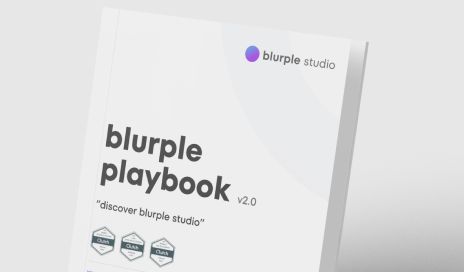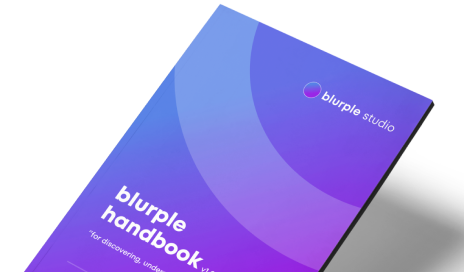This is Blurple Handbook
this is our universe, the recipe of principles & creativity.
Design Methodology
Design Methods
At Blurple, our design methods are guided by a commitment to user-centricity, rigorous testing, and collaboration. By employing advanced tools and techniques, we ensure that every design decision is informed, validated, and optimized to meet the needs of our clients and their users.
1. Research-Driven Design
- User Research:
- We start every project with comprehensive user research, including surveys, interviews, and observational studies, to gain deep insights into user behavior and pain points.
- Competitor Analysis:
- We analyze industry trends and competitor strategies to identify opportunities for differentiation and innovation.
- Data Integration:
- Analytics and real-time user data inform our design choices, ensuring relevance and effectiveness.
2. Wireframe and Prototype Testing
- Early Validation:
- Before moving into UI design, we rigorously test wireframes and prototypes to validate user flows and functionality.
- Global User Testing:
- We partner with a global user experience company, allowing us to conduct online user experience tests with targeted audiences in over 55 countries. This enables same-day insights from diverse user groups.
- Iterative Refinement:
- Feedback from wireframe testing informs iterative design improvements, ensuring the final product is both intuitive and effective.
3. Collaborative Design Process
- Cross-Functional Workshops:
- Designers, researchers, and stakeholders collaborate in workshops to align on goals, ideate solutions, and refine concepts.
- Client Involvement:
- Clients are involved at every stage, from wireframe reviews to usability testing, ensuring their vision is realized.
4. Advanced Usability Testing
- Multiphase Testing:
- We conduct usability tests at multiple stages of the design process, from early wireframes to high-fidelity prototypes.
- Diverse User Groups:
- Our testing includes diverse user demographics to ensure accessibility and inclusivity.
- Online Testing Tools:
- We leverage cutting-edge platforms for remote usability testing, enabling quick and cost-effective insights.
5. Accessibility and Inclusivity
- W3C Standards Compliance:
- All designs adhere to global accessibility standards to ensure they are usable by people with disabilities.
- Inclusive Design Practices:
- We design for a broad spectrum of users, considering cultural, linguistic, and physical diversity.
6. Delivering Data-Driven Design
- Continuous Learning:
- Every project contributes to our growing repository of design knowledge, enabling us to refine our methods and stay ahead of industry trends.
- Scalable Solutions:
- Our designs are built to adapt and grow with our clients’ needs, ensuring long-term value and usability.








